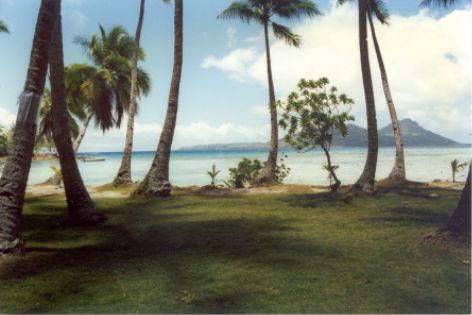|












| |
 Dublon Island
Dublon Island
Truk Lagoon was a large Japanese fleet
anchorage and air base in the mid-Pacific during WWII. The lagoon is an atoll where there are over forty wrecks of Japanese
merchant ships that were sunk by American aircraft in February 1944. A chart
of the main islands in the huge lagoon shows the location of the wreck sites
that we visited.
We usually had lunch
on Eten Island, which was transformed into an airstrip by the Japanese and has to its
credit a Zero fighter, a Betty bomber, and an Emily flying boat in the water nearby. The
island airstrip is now a coconut and banana plantation.
The following is a summary of
the wrecks that we dived in 1998.
| Aikoku Maru |
The ship was used as a combined freighter/passenger liner. The stern
lies at 73 metres, and the bow is completely missing. Stern gun is
at 50 metres, superstructure, living quarters. |
| Fujikawa Maru |
This freighter
is 132 metres long and lies upright in 34 metres of water. The ship was mainly used to
transport aircraft. Bow
gun, aircraft parts, Zeros, superstructure, engine room, officer's
bathroom, galley, stern
gun. |
| Heian Maru |
The
largest ship in the lagoon (155 metres long and 11,616 tons) lying on its port side in
33 metres. It was a
passenger and cargo liner converted into a submarine depot ship. Propellers,
periscopes, torpedoes, ship’s name. |
| Kansho Maru |
This
freighter is 116 metres long and lies upright in 40 metres. Bow
gun, artefacts, engine room, steering gear, bomb damage to stern. |
| Nippo
Maru |
This
water transport ship is 107 metres long and lies with a list to port at 45
metres. Tank, truck, shells, toppled funnel, Howitzers, paravanes, bottles. |
| Rio de Janeiro Maru |
Passenger
liner, converted into a submarine depot ship,
then to a transport. It is 140
metres long and lies on its starboard side in 39
metres. Bow gun, promenade deck,
beer
bottles, stern gun, propellers. |
| San Francisco
Maru |
An older style freighter, 117 metres
long, lying upright at 60 metres. The
ship was used to carry munitions. Bow
gun, mines, trucks, tanks, steamroller, engine room, torpedo hole,
cartridges, shells, torpedoes, depth charges. |
| Shinkoku
Maru |
Fleet oil
tanker is 152 metres long, 10,020 tons and sits upright in 40 metres of
water. Hole
in port side, engine room, bridge, officer’s bathroom. |
| Shotan Maru |
An 87-metre freighter
sitting in a valley with a sand hill on the
starboard side. The ship lies
upright at about 50 metres.
Stern
gun, bomb damage, superstructure, anti-aircraft guns, funnel, trucks,
windlasses. |
| Unkai Maru |
This
freighter is 93 metres long and lies upright in 40 metres. Engine
room, bow gun, shoes, gas masks, bottles. |
As the boat circled over the San
Francisco Maru on our third visit to that wreck, Chenny said quietly, “I
should tell you that a local diver died here yesterday”. He had collapsed in
his boat and died, presumably from an embolism. This unfortunate outcome is not
surprising since local divers are not trained in decompression diving, and do
not have adequate safety equipment. In the two previous dives on this wreck,
Neil had noticed that there were very few mines in Hold 1 whereas it had been
full in 1991. Apparently, local
divers retrieve the mines for use in fishing by explosives. Three divers had been crippled by decompression sickness, and
one had just paid the ultimate price for this dangerous occupation.
Read the published story of our
trip in the articles section.
Visit the following related
websites:
Useful references:
Hailstorm
Over Truk Lagoon, by Klaus
Lindemann.
20 Principal Shipwrecks of Truk Lagoon,
sketches by Captain Lance Higgs of S.S. Thorfinn.
Truk Lagoon Wreck Divers Map,
by Dan E. Bailey.
Jane's Fighting Aircraft of World War II.
|